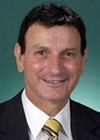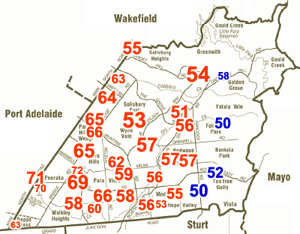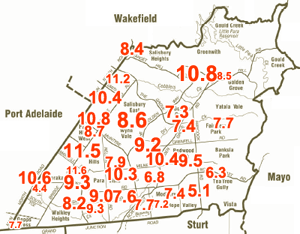Electoral Form Guide: Makin
Electorate: Makin
Margin: Labor 7.7%
Location: North-Eastern Adelaide, South Australia
In a nutshell: Makin has been South Australia’s only “bellwether” electorate since its creation in 1984, having been gained for the Liberals by Trish Draper in 1996 and for Labor by Tony Zappia in 2007. However, the present margin indicates the extent to which the Liberals punched above their weight in this and other mortgage belt areas during the Howard years.
The candidates
|
|
JASEMIN ROSE
|
|
|
Two-party vote map
|
Swing % map |
Electorate analysis: The north-eastern Adelaide seat of Makin was one of three Labor gains in South Australia at the 2007 election, along with Kingston in the south of the city and Wakefield in its outer north. Makin was created in 1984 from an area that had mostly formed the southern end of Bonython, a seat made safe for Labor by Elizabeth to the north-east (until its abolition at the 2004 election). Makin currently extends from Para Hills and Walkley Heights near the city to Tea Tree Gully and Greenwith at the limits of the metropolitan area. Labor rules the roost as far east as Salisbury East and Modbury North, beyond which are suburbs with somewhat higher incomes. Census data prepared before the 2007 election by George Megalogenis of The Australian shows the seat to be highly sensitive to interest rates, coming nineteenth on the ranking of electorates with the most mortgage payers and ninth on “couple families with dependent children paying off home”. However, it also ranks in the lowest quarter on mortgage burden (“median repayment divided by median income”) and the lowest third on “median household income for those paying off their homes”.
Makin was held for Labor by uncomfortable margins from 1984 to 1996 by Peter Duncan, a former Attorney-General in Don Dunstan’s state government. A 4.8 per cent swing put Duncan on the Keating government casualty list in 1996, and he returned to the headlines in 2007 after being charged with fraudulently obtaining government grants for his plastics recycling company. His Liberal successor was former nurse Trish Draper, who emerged as a prime ministerial favourite after strong performances at the next two elections. The swing to Labor in 1998 was just 0.2 per cent, and Draper bettered her 1996 margin when she picked up a 3.0 per cent swing in 2001. She went on to hit serious trouble in the lead-up to the 2004 election when it emerged she had taken a boyfriend on a study trip to Europe at taxpayers’ expense, in breach of rules limiting the benefit to spouses. Draper nonetheless survived by 0.9 per cent at the 2004 election, despite suffering a swing in every booth which mostly failed to carry over into neighbouring seats. She retired at the 2007 election citing an illness in the family, before unsuccessfully attempting a comeback in the state seat of Newland at the March 2010 election.
The open contest at the 2007 election was between Liberal candidate Bob Day, housing tycoon and national president of the Housing Industry Association, and Labor’s Tony Zappia, who had been the unsuccessful candidate in 2004, mayor of Salisbury since 1997, councillor for many years beforehand, and formerly a weightlifting champion. Zappia was widely reckoned to have been hard done by when he lost the 2001 Labor preselection to the Right’s Julie Woodman, essentially due to his factional non-alignment. A repeat performance appeared to be on the cards at the 2004 election, when the factions cut a three-way deal that was to deliver Hindmarsh to Steve Georganas of the “soft Left”, Adelaide to Kate Ellis of the Right and Makin to Dana Wortley of the “hard Left”. The nomination of Wortley was to serve the purposes of soft Left warlord Nick Bolkus, as it would allow the party’s affirmative action target to be met without costing him his seat in the Senate. However, the arrangement displeased local branches as well as party hard-heads who were concerned that the crucial marginal seat should be contested by the most appealing candidate. Premier Mike Rann prevailed upon Wortley’s backers to throw their weight behind Zappia, and Bolkus shifted his focus to having the party loosely interpret its affirmative action requirement. His problem appeared solved when another Senator, Geoff Buckland, announced his retirement and backed former state deputy leader Annette Hurley to replace him. Perversely, Bolkus then decided that he too would call it a day, leading to suggestions he had only been holding on to thwart the ambitions of state minister Patrick Conlon (the member for Elder).
Despite a high-impact publicity campaign by Bob Day, which had reportedly already cost him $100,000 seven months before the election, Zappia enjoyed a resounding victory on his second attempt, demolishing the 0.9 per cent Liberal margin with an 8.6 per cent swing that was evenly distributed throughout the electorate. This time he faces Liberal candidate Liz Davies, chief executive of Storpac Smart Storage at Holden Hill.

 In the second week of the campaign Julia Gillard announced $100 million in funding for stormwater harvesting and reuse, the first cab off the rank being a $10 million contribution to a pitch for $33 million by councils in eastern Adelaide. With the councils to fund half the cost, this left a $6 million hole which Labor wanted filled by a previously reluctant state government. The next day Tony Abbott trumped Labor by promising to put up the full $16.5 million.
In the second week of the campaign Julia Gillard announced $100 million in funding for stormwater harvesting and reuse, the first cab off the rank being a $10 million contribution to a pitch for $33 million by councils in eastern Adelaide. With the councils to fund half the cost, this left a $6 million hole which Labor wanted filled by a previously reluctant state government. The next day Tony Abbott trumped Labor by promising to put up the full $16.5 million.
Analysis written by William Bowe. Read Bowe’s blog, The Poll Bludger.





